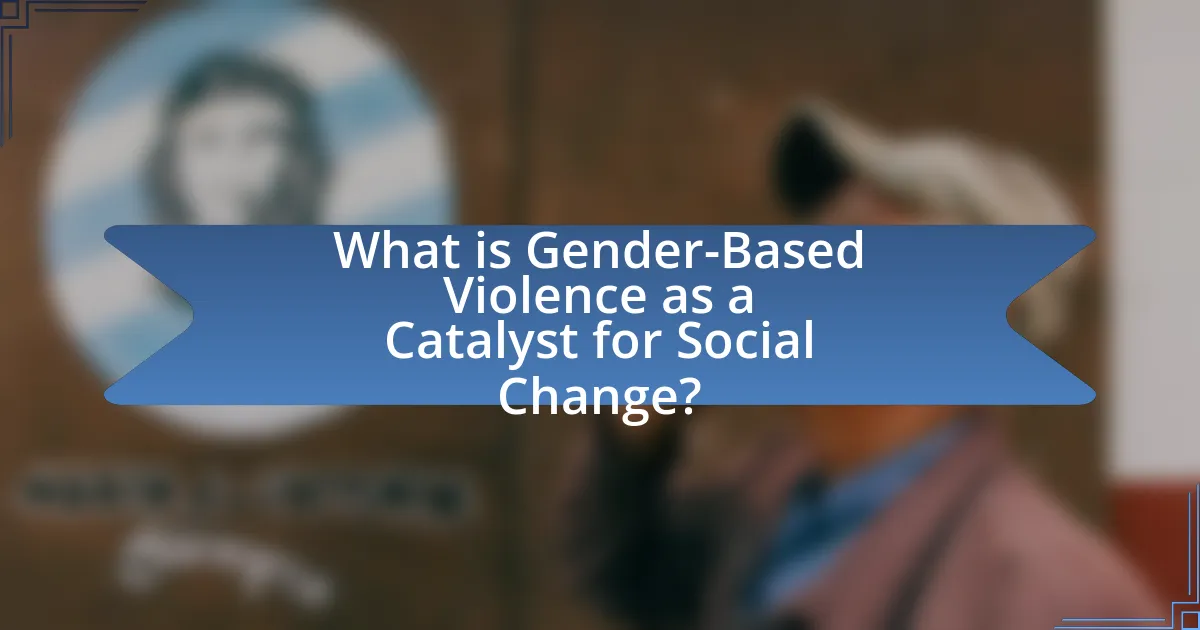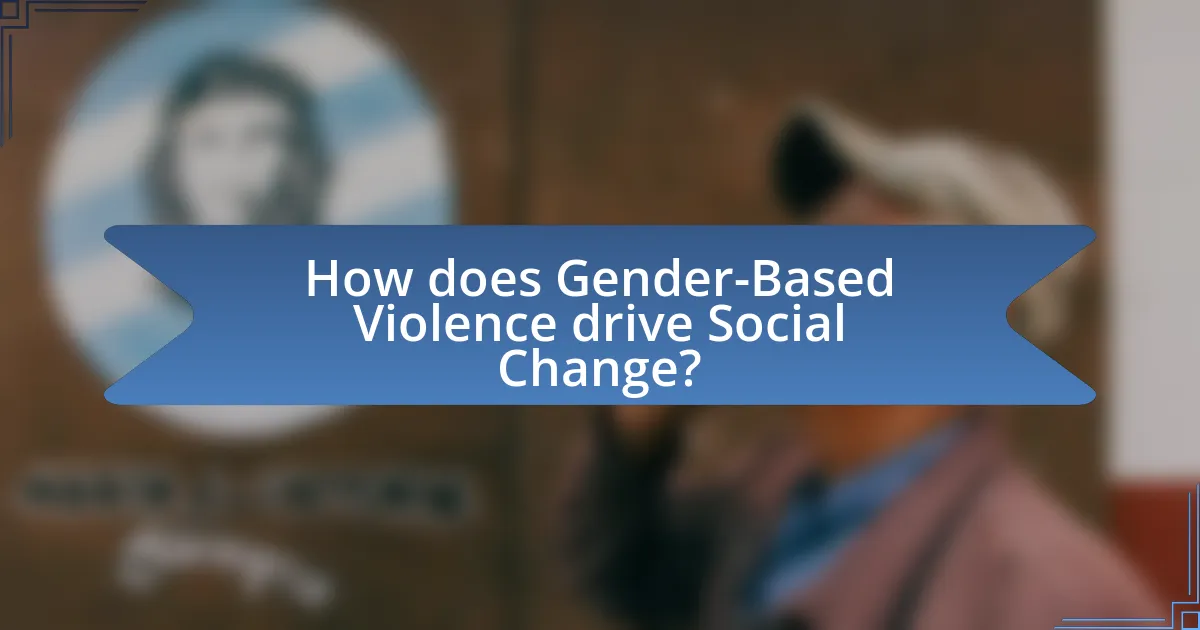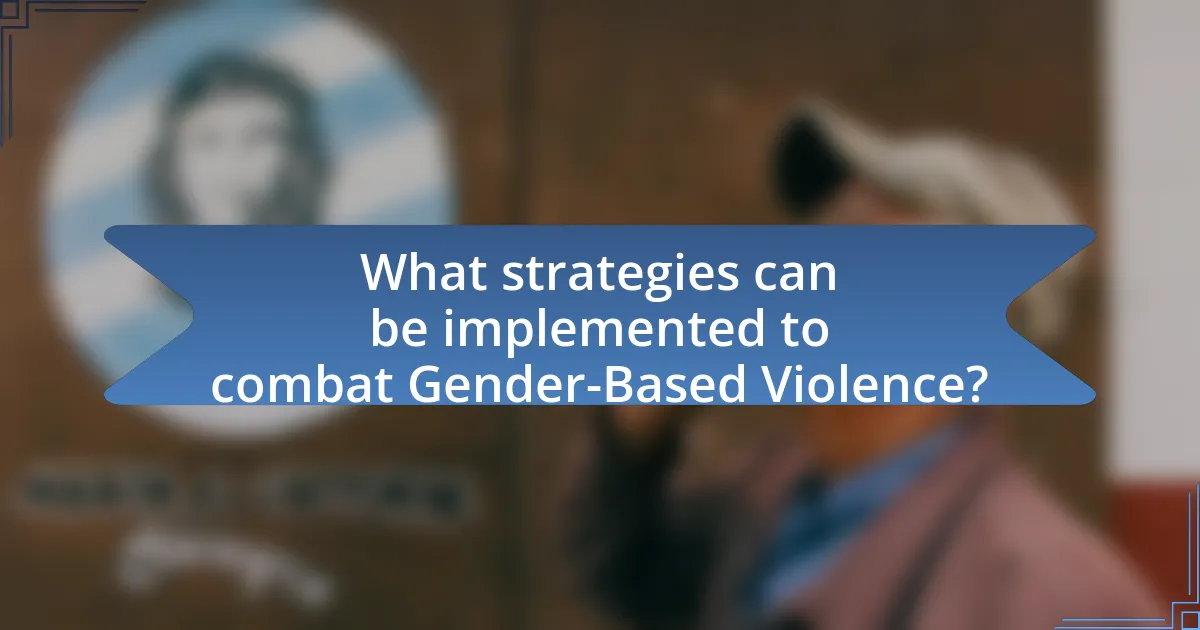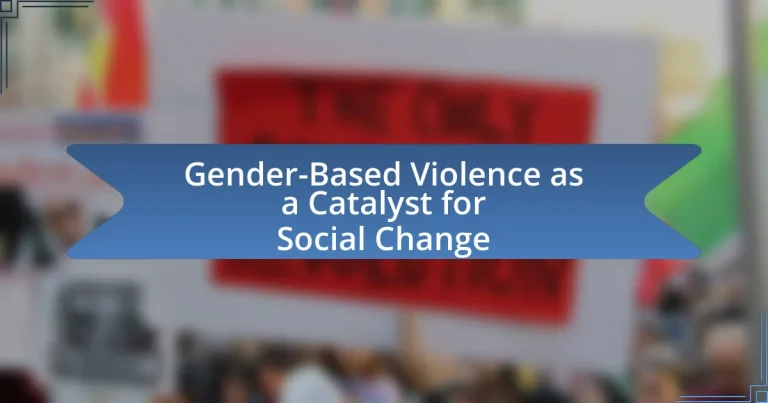Gender-Based Violence (GBV) is defined as harmful acts directed at individuals based on their gender, encompassing various forms of abuse such as physical, sexual, emotional, and economic violence. The article explores how GBV acts as a catalyst for social change by exposing systemic inequalities and mobilizing communities for policy reforms and awareness initiatives aimed at promoting gender equality. It discusses the definitions and forms of GBV, the cultural influences on its perception, and its classification as a social issue with significant societal impacts. Furthermore, the article highlights the importance of awareness, education, and grassroots movements in combating GBV, as well as the role of legal systems and community programs in providing support and resources for survivors.

What is Gender-Based Violence as a Catalyst for Social Change?
Gender-Based Violence (GBV) serves as a catalyst for social change by highlighting systemic inequalities and prompting societal awareness and action. GBV exposes the pervasive nature of discrimination and violence against marginalized groups, particularly women, which can lead to mobilization for policy reforms and community initiatives aimed at promoting gender equality. For instance, the #MeToo movement has galvanized global conversations about sexual harassment and assault, resulting in legislative changes in various countries, such as the strengthening of laws against domestic violence in Spain. This demonstrates how GBV can drive collective action and foster a cultural shift towards greater accountability and support for victims, ultimately contributing to a more equitable society.
How is gender-based violence defined in various contexts?
Gender-based violence is defined as harmful acts directed at individuals based on their gender, encompassing physical, sexual, emotional, and psychological abuse. In various contexts, such as legal frameworks, healthcare, and social services, gender-based violence is recognized as a violation of human rights and a public health issue. For instance, the World Health Organization identifies intimate partner violence and sexual violence as significant contributors to women’s health problems globally, affecting one in three women in their lifetime. Additionally, the United Nations defines gender-based violence in its Declaration on the Elimination of Violence Against Women, emphasizing that it includes acts that cause physical, sexual, or psychological harm. These definitions highlight the multifaceted nature of gender-based violence and its implications across different societal sectors.
What are the different forms of gender-based violence?
Different forms of gender-based violence include physical violence, sexual violence, emotional or psychological abuse, economic abuse, and harmful traditional practices. Physical violence encompasses acts such as hitting, slapping, or any form of bodily harm. Sexual violence involves coercion or force to engage in sexual acts, including rape and sexual assault. Emotional or psychological abuse refers to behaviors that undermine an individual’s self-worth, such as intimidation or manipulation. Economic abuse restricts access to financial resources, limiting independence. Harmful traditional practices include practices like female genital mutilation and forced marriage, which are often rooted in cultural beliefs. According to the World Health Organization, approximately one in three women globally has experienced either physical or sexual violence in their lifetime, highlighting the prevalence and urgency of addressing these forms of violence.
How does cultural context influence the perception of gender-based violence?
Cultural context significantly influences the perception of gender-based violence by shaping societal norms, values, and attitudes towards gender roles. In societies where traditional gender roles are deeply entrenched, acts of violence against women may be normalized or justified, leading to a lack of accountability for perpetrators. For instance, a study by the World Health Organization indicates that in cultures with strong patriarchal structures, women often face higher rates of domestic violence, as their roles are primarily seen as submissive. Conversely, in cultures that promote gender equality, there is a greater recognition of gender-based violence as a violation of human rights, resulting in stronger legal frameworks and support systems for victims. This illustrates that cultural context not only affects individual perceptions but also influences institutional responses to gender-based violence.
Why is gender-based violence considered a social issue?
Gender-based violence is considered a social issue because it reflects and perpetuates systemic inequalities and power imbalances within society. This form of violence affects individuals across various demographics, leading to widespread physical, emotional, and psychological harm. According to the World Health Organization, approximately one in three women worldwide has experienced physical or sexual violence, highlighting its prevalence and societal impact. Furthermore, gender-based violence undermines community cohesion and economic stability, as it often results in significant healthcare costs and lost productivity. Thus, addressing gender-based violence is essential for fostering social equity and improving overall societal well-being.
What are the societal impacts of gender-based violence?
Gender-based violence has profound societal impacts, including the perpetuation of inequality, economic costs, and public health crises. This form of violence reinforces gender stereotypes and discrimination, leading to systemic inequality where women and marginalized groups face barriers in education, employment, and political participation. According to the World Health Organization, gender-based violence results in significant healthcare costs, with estimates suggesting that it costs countries billions annually in healthcare, legal services, and lost productivity. Furthermore, the prevalence of gender-based violence contributes to mental health issues, such as depression and anxiety, affecting not only the victims but also their families and communities. These societal impacts highlight the urgent need for comprehensive strategies to address and prevent gender-based violence, ultimately fostering a more equitable society.
How does gender-based violence intersect with other social issues?
Gender-based violence intersects with other social issues such as poverty, health disparities, and systemic inequality. This intersectionality reveals that individuals experiencing gender-based violence often face compounded challenges; for instance, women in low-income communities may lack access to resources that could help them escape abusive situations. According to the World Health Organization, intimate partner violence is more prevalent in settings where economic instability exists, highlighting the link between financial hardship and increased vulnerability to violence. Furthermore, gender-based violence can exacerbate health issues, as survivors may experience long-term physical and mental health consequences, which are often overlooked in healthcare systems that fail to address these specific needs. Thus, the relationship between gender-based violence and other social issues underscores the necessity for comprehensive approaches to address these interconnected challenges.
What role does awareness play in addressing gender-based violence?
Awareness plays a crucial role in addressing gender-based violence by educating individuals about its prevalence, consequences, and the importance of prevention. Increased awareness leads to greater recognition of harmful behaviors and societal norms that perpetuate violence, enabling communities to challenge and change these dynamics. For instance, campaigns like the United Nations’ “16 Days of Activism Against Gender-Based Violence” have successfully raised awareness, resulting in increased reporting of incidents and support for survivors. Research indicates that communities with higher awareness levels see a reduction in gender-based violence rates, demonstrating the effectiveness of awareness initiatives in fostering social change.
How can education contribute to reducing gender-based violence?
Education can significantly contribute to reducing gender-based violence by promoting awareness, fostering critical thinking, and encouraging respectful relationships. By integrating gender studies and human rights education into curricula, individuals can learn about the consequences of violence and the importance of equality. Research indicates that educational programs addressing gender norms and violence prevention can lead to a decrease in incidents of gender-based violence; for instance, a study by the World Health Organization found that school-based interventions reduced violence by up to 50% in some communities. Thus, education serves as a powerful tool in shaping attitudes and behaviors that combat gender-based violence.
What are effective awareness campaigns related to gender-based violence?
Effective awareness campaigns related to gender-based violence include initiatives like the “16 Days of Activism Against Gender-Based Violence,” which mobilizes individuals and organizations globally to raise awareness and advocate for the elimination of violence against women. This campaign has been recognized for its extensive reach and impact, engaging millions through social media, educational programs, and community events. Another notable campaign is “HeForShe,” launched by UN Women, which encourages men to advocate for gender equality and challenge harmful stereotypes, resulting in significant engagement from male allies worldwide. Research indicates that campaigns utilizing personal stories and testimonials, such as the “No More” campaign, effectively resonate with audiences, leading to increased awareness and action against gender-based violence. These campaigns demonstrate the power of collective action and targeted messaging in driving social change.

How does Gender-Based Violence drive Social Change?
Gender-Based Violence (GBV) drives social change by highlighting systemic inequalities and mobilizing communities to advocate for gender equality and justice. The prevalence of GBV often prompts public awareness campaigns, policy reforms, and grassroots movements aimed at addressing the root causes of violence against marginalized groups. For instance, the #MeToo movement, which gained global traction in 2017, has led to significant changes in workplace policies and increased accountability for perpetrators, demonstrating how collective action against GBV can reshape societal norms and legal frameworks. Additionally, research indicates that countries with strong responses to GBV, such as comprehensive legal protections and support services, experience broader social transformations, including improved gender equity and economic participation for women.
What are the mechanisms through which gender-based violence catalyzes change?
Gender-based violence catalyzes change through mechanisms such as raising awareness, mobilizing communities, influencing policy reforms, and fostering solidarity among marginalized groups. These mechanisms create a societal impetus for addressing underlying gender inequalities. For instance, awareness campaigns highlight the prevalence and impact of gender-based violence, leading to increased public discourse and community engagement. Mobilization efforts, such as grassroots movements, unite individuals to advocate for systemic changes, exemplified by initiatives like the #MeToo movement, which has prompted legislative changes in various countries. Additionally, gender-based violence often serves as a catalyst for policy reforms aimed at protecting victims and holding perpetrators accountable, as seen in the enactment of stricter laws in response to public outcry. Finally, the solidarity fostered among affected individuals and communities strengthens collective action, driving societal change towards greater gender equality.
How does public outrage influence policy reform?
Public outrage significantly influences policy reform by mobilizing public opinion and pressuring lawmakers to act. When communities express strong discontent over issues such as gender-based violence, this collective sentiment can lead to increased media coverage, which amplifies the urgency for change. For instance, the #MeToo movement, which gained momentum in 2017, resulted in legislative changes across various states in the U.S., including the passing of laws aimed at strengthening protections against sexual harassment and assault. This demonstrates that sustained public outrage can create a political environment where policymakers feel compelled to address the concerns of their constituents, ultimately leading to reforms that reflect the demands of the public.
What role do grassroots movements play in advocating for change?
Grassroots movements play a crucial role in advocating for change by mobilizing community members to address issues such as gender-based violence. These movements empower individuals to raise awareness, influence public policy, and create social norms that challenge systemic injustices. For instance, the #MeToo movement, which began as a grassroots initiative, successfully highlighted the prevalence of sexual harassment and assault, leading to significant legislative changes and increased societal accountability. Research indicates that grassroots activism can effectively shift public perception and drive policy reform, as seen in various campaigns that have resulted in stronger protections for victims of gender-based violence.
Why is it important to address gender-based violence for social progress?
Addressing gender-based violence is crucial for social progress because it directly impacts the health, safety, and equality of individuals and communities. Gender-based violence perpetuates cycles of inequality and hinders economic development; for instance, the World Health Organization reports that violence against women can lead to significant healthcare costs and lost productivity, costing economies billions annually. Furthermore, addressing this issue fosters a culture of respect and equality, which is essential for sustainable social development. By tackling gender-based violence, societies can create safer environments, promote gender equality, and enhance overall social cohesion, leading to more robust and equitable communities.
How does addressing gender-based violence contribute to gender equality?
Addressing gender-based violence directly contributes to gender equality by dismantling the systemic power imbalances that perpetuate discrimination and inequality. When societies actively combat gender-based violence, they create safer environments that empower individuals, particularly women, to participate fully in social, economic, and political spheres. Research indicates that countries with robust measures against gender-based violence experience higher levels of women’s participation in the workforce and politics, leading to more equitable decision-making processes. For instance, a study by the World Health Organization found that reducing violence against women can lead to significant improvements in women’s health and economic status, thereby fostering greater gender equality.
What are the long-term benefits of reducing gender-based violence in society?
Reducing gender-based violence in society leads to significant long-term benefits, including improved public health, economic growth, and enhanced social cohesion. Improved public health results from decreased physical and mental health issues associated with violence, as studies indicate that survivors of gender-based violence often experience long-term psychological trauma and chronic health conditions. Economic growth is fostered as a safer environment allows for greater participation of women in the workforce, contributing to increased productivity; for instance, the World Bank estimates that eliminating gender-based violence could add $1.5 trillion to the global economy. Enhanced social cohesion occurs as communities become more inclusive and supportive, leading to stronger social networks and reduced crime rates. These benefits collectively contribute to a more equitable and prosperous society.

What strategies can be implemented to combat Gender-Based Violence?
To combat Gender-Based Violence, comprehensive strategies must be implemented, including legal reforms, education and awareness campaigns, and support services for survivors. Legal reforms can strengthen laws against gender-based violence, ensuring stricter penalties and better enforcement, as seen in countries like Spain, where the 2004 Comprehensive Law on Gender Violence has led to increased reporting and prosecution rates. Education and awareness campaigns can challenge societal norms and stereotypes that perpetuate violence, as demonstrated by initiatives like the UN’s “HeForShe” campaign, which engages men and boys in the fight for gender equality. Additionally, providing accessible support services, such as hotlines and shelters, is crucial; research indicates that countries with robust support systems see higher rates of survivor recovery and lower rates of repeat victimization.
What are the best practices for prevention and intervention?
The best practices for prevention and intervention in the context of gender-based violence include comprehensive education, community engagement, and policy advocacy. Comprehensive education programs that address the root causes of gender-based violence, such as gender inequality and harmful stereotypes, have been shown to reduce incidents of violence. For instance, the “Safe Dates” program has demonstrated a 56% reduction in dating violence among adolescents. Community engagement initiatives, such as bystander intervention training, empower individuals to take action and support victims, fostering a culture of accountability. Additionally, advocating for policies that strengthen legal protections and support services for survivors is crucial; countries with robust legal frameworks report lower rates of gender-based violence. These practices collectively contribute to a more informed and proactive society, effectively addressing and mitigating gender-based violence.
How can community programs effectively address gender-based violence?
Community programs can effectively address gender-based violence by implementing comprehensive education and prevention strategies that engage the entire community. These programs often include workshops that raise awareness about the signs of abuse, promote healthy relationships, and provide resources for victims. For instance, studies show that community-based interventions can reduce intimate partner violence by up to 50% when they involve both men and women in discussions about gender norms and violence prevention. Additionally, programs that offer support services, such as counseling and legal assistance, empower survivors and help them rebuild their lives, further contributing to a decrease in gender-based violence.
What role do law enforcement and legal systems play in combating gender-based violence?
Law enforcement and legal systems play a critical role in combating gender-based violence by enforcing laws, providing protection to victims, and holding perpetrators accountable. Law enforcement agencies are responsible for responding to incidents of gender-based violence, conducting investigations, and ensuring that offenders are prosecuted under relevant laws. For instance, the implementation of laws such as the Violence Against Women Act in the United States has led to increased reporting and prosecution of domestic violence cases, demonstrating the effectiveness of legal frameworks in addressing this issue. Additionally, legal systems provide avenues for victims to seek justice and obtain protective orders, which can significantly reduce the risk of further violence. Statistics indicate that jurisdictions with robust legal protections and active law enforcement responses see lower rates of gender-based violence, underscoring the importance of these systems in fostering a safer environment for individuals affected by such violence.
How can individuals contribute to the fight against gender-based violence?
Individuals can contribute to the fight against gender-based violence by actively educating themselves and others about the issue, advocating for policy changes, and supporting survivors. Education fosters awareness, as studies show that informed communities are less tolerant of violence; for instance, a report by the World Health Organization indicates that educational programs can reduce violence by up to 50%. Advocacy for policy changes can lead to stronger legal protections and resources for victims, as seen in countries that have implemented comprehensive laws against domestic violence. Supporting survivors through resources, such as shelters and counseling services, directly aids those affected, with research indicating that access to support services significantly improves recovery outcomes.
What actions can individuals take to support survivors of gender-based violence?
Individuals can support survivors of gender-based violence by actively listening to their experiences and providing emotional support. This approach fosters a safe environment for survivors to share their stories, which is crucial for their healing process. Research indicates that survivors who feel heard and validated are more likely to seek help and recover from trauma. Additionally, individuals can educate themselves about the dynamics of gender-based violence and advocate for policy changes that protect survivors, as informed advocacy can lead to systemic improvements in support services. Engaging in community awareness campaigns also helps to destigmatize the issue and encourages others to take action, creating a broader support network for survivors.
How can bystanders effectively intervene in situations of gender-based violence?
Bystanders can effectively intervene in situations of gender-based violence by employing strategies such as direct intervention, distraction, and seeking help from authorities. Direct intervention involves confronting the aggressor or supporting the victim in a safe manner, which can deter the violence and provide immediate assistance. Distraction techniques, such as creating a diversion or engaging the victim in conversation, can help to diffuse the situation without escalating it. Additionally, bystanders should not hesitate to call law enforcement or seek assistance from security personnel, as professional intervention can be crucial in ensuring the safety of the victim. Research indicates that active bystander intervention can significantly reduce incidents of violence, as demonstrated in studies published by the Journal of Interpersonal Violence, which highlight the effectiveness of community engagement in preventing gender-based violence.
What resources are available for those affected by gender-based violence?
Resources available for those affected by gender-based violence include hotlines, shelters, counseling services, and legal assistance. National hotlines, such as the National Domestic Violence Hotline in the United States, provide immediate support and guidance, receiving over 300,000 calls annually. Shelters offer safe housing and support services, with many organizations like the YWCA providing comprehensive care for survivors. Counseling services, often available through local nonprofits, help individuals process trauma and develop coping strategies. Legal assistance is crucial, with organizations like the Legal Aid Society offering free legal representation to help survivors navigate the justice system. These resources collectively aim to empower survivors and facilitate recovery from the impacts of gender-based violence.
How can survivors access support services and legal assistance?
Survivors can access support services and legal assistance through various channels, including local advocacy organizations, hotlines, and legal aid clinics. These resources often provide confidential support, counseling, and legal representation tailored to the needs of survivors. For example, the National Domestic Violence Hotline offers 24/7 support and can connect individuals to local services, while organizations like Legal Aid provide free legal assistance to those who qualify. Accessing these services can empower survivors to navigate their options and seek justice effectively.
What role do hotlines and shelters play in providing immediate help?
Hotlines and shelters serve as critical resources for individuals experiencing gender-based violence by offering immediate support and safety. Hotlines provide 24/7 access to trained professionals who can offer emotional support, crisis intervention, and information about available resources, enabling victims to make informed decisions. Shelters offer a safe haven, protecting individuals from further harm while providing essential services such as counseling, legal assistance, and access to healthcare. According to the National Domestic Violence Hotline, 70% of individuals who reach out for help report feeling safer after contacting a hotline, highlighting their effectiveness in crisis situations.


